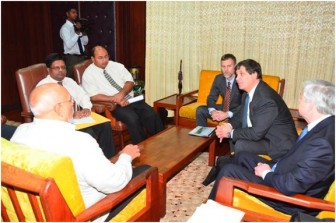Executives of Sithe Global, the developer of the Amaila Falls Hydro Project, are counting on the Inter-American Development Bank (IDB) to provide critical financing for the project.
This follows the decision by the World Bank not to participate, which stupefied officials of the hydro project developer, who said that the institution has always thrown its weight and funds towards similar projects around the world and they cited the most recent case in a project in the Philippines.
The officials are now hoping that financial closure comes soon –by June this year—since further delays could see this present window of locking in a fixed price being closed and increasing the possibility of the final cost of the project escalating further. As it stands, the cost of the project is US$840 million, increased significantly because of currency movements, commodity prices and political risk insurance that had to be sought for the financing of the project.

“If all goes well we think that there is a good chance to close financing on the project and begin construction by June of this year,” said Bruce Wrobel, Chief Executive Officer of Sithe Global during the media encounter held at the Pegasus Hotel yesterday.
Wrobel, along with Senior Vice Presidents for Development Brian Kubeck and James McGowan, are in Guyana to speak to various stakeholders with a view to clearing up issues that they may have about the project, especially with regards to its cost.
“Once financing comes in we believe that this project becomes a reality and there is going to be a long construction period – four years from now the power would be coming online into the grid. We are trying to convey by coming to Guyana this week is how critical this project is to the power sector of Guyana going forward. It will result in hundreds of millions of dollars in savings to the consumer in Guyana over the period of the project,” Wrobel said.
Sithe Global has invested some US$11 million in engineering for the project and while it said it is by no means its biggest investment in a project, it is a very exciting one for the company. “This is the first time that we have been involved in something where we have 100 percent dependence on thermal energy and in a single project we are going to convert that nation into 100 percent renewable energy,” he said. Sithe Global is hoping to invest US$175 million in equity for the project and said its rate of return as negotiated is 19 percent. Because of this, the company is hoping that the cost of the project goes down and not up, so as to assure the project’s ability to pay back on the equity.
“We consider ourselves on the same side of the table with government on this,” he added, speaking of the shared interest in having the lowest possible project cost settled upon.
Very difficult
Wrobel admitted that should financing not come through from the IDB or the China Development Bank (CDB), “It will be very difficult for us.” He said that commercial banks do not typically lend to projects such as this. “It requires those multilateral and bilateral financing. We have strong support from the CDB right now. We do believe that the CDB is there. IDB is the last critical piece. We are a bit surprised in the fact that the World Bank, which typically lends money to projects like these that we’ve been involved with, pulled out supporting the project with finance so IDB becomes critical in this,” said Wrobel.
“If we get that approval from the IDB, then we are very confident that we could get it to the finish line,” he said.
On the importance of financially closing by June, Wrobel said that there has been a lot of information in the press about price increases over the past year and a half. “More than half of the increase in the construction price came from currency changes: the Renminbi (Chinese currency) versus the US Dollar,” he said, while explaining that because the contractor is a Chinese company and the equipment is coming from China, any further movements in the currency would result in additional increases in price.
“As you know there is a lot of pressure from the European and Americans for the Chinese to appreciate their currency further. We need to get this financing closed before there is any further currency adjustments,” he said. “We see the pressures on the Chinese to appreciate their currency are strong and we do not want to go through another round of cost increases,” Wrobel said.
Wrobel noted that the major impediment to the project is the IDB’s pending decision whether or not to support the project. He said that one of the concerns on the part of the IDB is the size and scale of the project relative to the size of the country and the sophistication of the utility.
“We ourselves believe that hydro is very simple. Hydro power has been around much longer than even electricity. This is not something that we perceive as difficult. But it is a big project. It is the biggest project that Guyana has ever undertaken. It is the biggest power project that GPL will have ever undertaken,” he said.
“These are the big concerns. Are there systems in place? Is the expertise in place to absorb a project of this size into the grid?” he asked.
He noted that the IDB is also concerned about environmental issues germane to the construction and operation of the project and has raised concerns also of continuing commercial losses of electricity. The Sithe Global CEO said that the IDB is presently conducting its technical and financial due-diligence of the project, the completion of which should see a decision for or against its financing being made in a month or so.
Pointing to the benefits of the project, he said that with the trends in oil prices, it will become unsustainable for the country to continue to be dependent on oil. He said that tariffs will become too high for persons to afford and it will drive away industry and investment from the country. Wrobel said that the project would save Guyana money spent on purchasing fuel and drive tariffs down significantly.
He said over the life of the project the operating cost for the facility would be minimal compared to fuel purchases. He said too that as the debt and equity are paid off, the price will get lower and lower and after 20 years the project is transferred to GPL. It will only be maintenance that has to be taken care of during the balance of the 75 plus year lifespan of the project.
Road
Wrobel said that while the Amaila Falls access road is a concern to Sithe Global, that in itself and the delays that have been experienced in that part of the project will not necessarily derail the bigger project. He said that the most important decision is the financing from the IDB. “It was determined a while back that the government would finance the access road prior to the major construction of the power plant. The contract of that project requires that the road is complete before the project [is started]. So we are looking for the road to be complete by that same June timeframe,” he said.
Further, Wrobel said that part of the trip would be spent with the Ministry of Public Works to assess the progress on the road and what could be done to help ensure that the road is completed on time. He acknowledged the fact that the government is taking steps to ensure that the road gets finished. “We are very anxious to work with government to see what could be done so that the road could be completed on time,” he said. Government recently announced that contractor for the road project Synergy Holdings has been axed over the failure to meet deadlines.
The Amaila Falls Hydro Project consists of a hydropower dam at the junction of the Amaila and Kuribrong rivers. The electricity will be generated by specially designed and purpose-built turbines and will be delivered to substations in Linden and Sophia by a new 270 KM and 230 KM long high voltage transmission lines respectively. The facility is expected to generate in excess of 150 megawatts of power.





